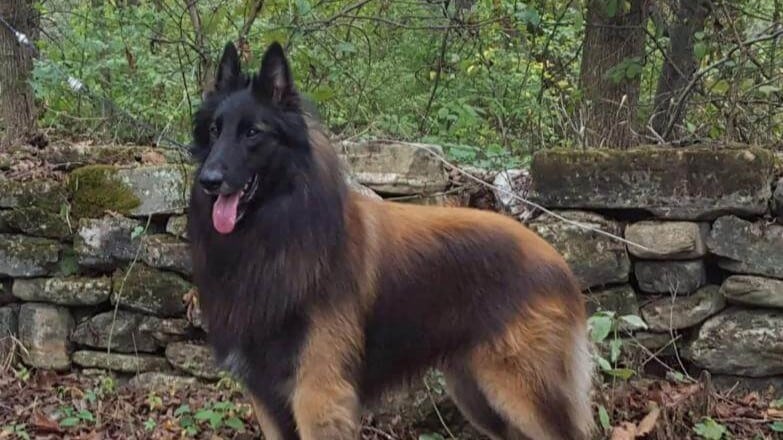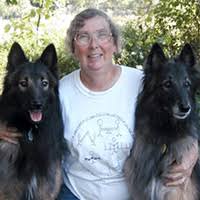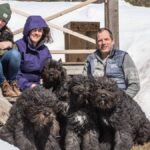Judging a Belgian Tervuren – Elegant, Bright, Self-Assured Herding Dog
Before you look at these amazing dogs, you need to stop a second and look at handlers—yes, that is exactly what I said! Most Belgian Tervuren are owner-handled. Some of those handlers are extremely capable and professional. Some are not. The odds are quite good you may have a total newbie in your ring, usually attached to a slightly rambunctious youngster.
Take a deep breath. Remember that these newbies are the future of the sport. Smile and be kind.
Then it is on to the dogs! The Belgian Tervuren is a “moderate dog.” There is not unusual movement such as the extreme reach and drive of the German Shepherd Dog. This is not a “coat breed,” and in fact, excessive coat, especially if soft, is not desired. While an elegant head can add to the silhouette, this is not a “head breed,” and heads are just one piece of the puzzle.
Our breed standard basically says it all: “The Belgian Tervuren is a herding dog and versatile worker. The highest value is to be placed on qualities that maintain these abilities, specifically, correct temperament, gait, bite and coat.”
Temperament and movement are essential parts of Terv type. Tervs are typically free stacked and should be shown on a loose lead. This is a natural breed. Feet and hocks may be neatly trimmed, but there should not be any “body sculpting.”
Belgian Tervuren are a “square” breed and that is reflected in the silhouette. It is important to note that the correct measuring points for a Terv as you eyeball the silhouette are from the point of shoulder to the point of rump. That measurement should be approximately equal to the height. Bitches get a little leeway on length. It should be obvious right away which sex a dog is—bitchy dogs and doggy bitches are both incorrect.
When looking at the head, the expression should be alert and intelligent. The eyes are dark and slightly almond shape. The stop is moderate. Ears are set high and equilateral triangles in shape. Ears are prick. Hanging or drop ears would be a disqualification.
Scissors or level bites are acceptable. You do not need to pry open the mouth to check teeth. Have the handler show the bite from the front, then lift the lips on either side to verify premolars. A loss of contact of all the incisors is a disqualification. Missing teeth are a fault with four or more a serious fault.
Head planes should be parallel and the length of the skull and the muzzle should be close to equal.
The topline should be level from withers to the croup. The body should be moderate in width—not broad, but not narrow. The chest should reach to the elbow. The tail should reach to the hock and be held low at rest. The tail should not curl over the back nor should it be tucked. Ideally, the tail should flow smoothly off the back when in motion though adolescent males and any male around bitches in heat may tend to carry it above the level of the topline. A cropped or stump tail is a disqualification.
Legs should be straight with oval bones. Pasterns should be strong and upright, with tight “cat feet” as the ideal in front and feet slightly longer in the rear. Hocks are slightly bent with metatarsi upright and straight to the ground.
The outer coat should be harsh. A correct coat will dry quickly and be less likely to pick up plant material while working in fields. Density and amount of undercoat will vary greatly with time of year and with heat cycles in bitches. Mature males should have an impressive “mane,” but don’t let coat cause you to overlook a quality bitch.
The coat color is described as “rich fawn to russet mahogany with black overlay is ideal and preferred. Predominate color that is pale, washed out, cream or gray is a fault.” If you have two dogs of equal quality, the red dog should be placed higher than the dog with lighter coloring. Blackening of the coat comes with age and is more prominent on the males. “Absence of blackening in mature dogs is a serious fault.”
Masks are an important part of color and type. A face with a complete absence of black is a serious fault. The mask may be muzzle only or it may cover almost the entire head.
Some minor white markings are acceptable—the tips of toes, chin, and muzzle as well as an area of the chest, but not more than three inches higher than the prosternum or reaching either shoulder. Chin “frosting” can appear in dogs as young as 18 months. Excess white, solid liver, or solid black color are all disqualifications.
There are height stipulations for Tervuren. The ideal male is 24 to 26 inches with the ideal bitch coming in at 22 to 24 inches. Disqualification is set for males under 23 or over 26.5 inches and for bitches under 21 or over 24.5 inches.
Movement should be free and easy. Tervs should tend to single track when moving fast at a trot. You want the maximum amount of ground covered with the minimum of effort—no “tinker toy” strides or hackneyed action—but they should also not have the tremendous reach and drive of a German Shepherd Dog. The ideal Terv on the move should look efficient and effortless.
As noted, temperament is of extreme importance. The standard states, “He must be approachable, standing his ground and showing confidence to meet overtures without himself making them.” This is a breed to approach confidently, but calmly. Remember, these dogs are mostly owner-handled. A kind word to set the handler at ease lets the dog know that this is all good.
The dog should not need to be propped or held up by the handler. If a death grip is required, you should excuse the dog. The show ring is not the time or the place to push a dog past its comfort zone.
When judging a Belgian Tervuren, it is important to keep the ABTC guidelines on faults in mind:
The extent to which it deviates from the standard.
The extent to which such deviation would actually affect the working ability of
the dog.
And as I mentioned above, repeating because it is so important,
“THE BELGIAN TERVUREN IS A HERDING DOG AND VERSATILE WORKER. THE HIGHEST VALUE IS TO BE PLACED ON QUALITIES THAT MAINTAIN THESE ABILITIES, SPECIFICALLY, CORRECT TEMPERAMENT, GAIT, BITE AND COAT.”










